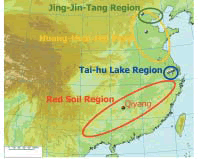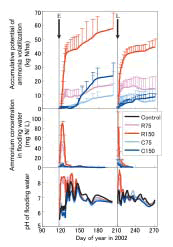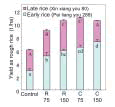Paddy field ammonia volatilization with double cropping and its control in the Red Soil Region of China
Description
[Objectives]
The People's Republic of China is the world's largest producer and consumer of food. New technologies and reform policies have substantially improved the conditions necessary to meet China's growing demand for grain. Yet the adverse environmental effects of intensive modern agriculture have recently raised concerns about land resource sustainability and the environment. Intensive farming has caused significant land degradation, irrigation water shortages, and air and water pollution, all of which are now serious issues in China. Many of these problems stem from farmlands being overloaded with nutrients, particularly nitrogen. China's use of nitrogen fertilizer has increased to 27.4% of world consumption, and a total of 22.4 × 106 tons of nitrogen were used in 2001 alone. Excess nitrogen in the environment poses numerous health and environmental problems.
A nitrogen cycling field experiment in the Red Soil Region, one of the most important double rice cropping hill areas in China, was carried out at the Red Soil Experimental Station, Chinese Academy of Agricultural Sciences, Qiyang County, Hunan Province (26°45'21"N, 111°52'22"E, Fig. 1). The goal was to quantify the present conditions of non-point source N pollution in the region and to develop methods to mitigate that pollution.
[Results]
Using a polyolefin-coated urea (MEISTER S9 for early rice, MEISTER 10 (40%) + MEISTER S15 (60%) for late rice) at a rate of 150 kg N/ha (conventional level) or 75 kg N/ha for each crop just after flooding (keeping other conditions the same), five treatments were prepared with triplicates. These were R150 (readily available urea at a rate of 150 kg N/ha), R75 (readily available urea at a rate of 75 kg N/ha), C150 (coated urea at a rate of 150 kg N/ha), C75 (coated urea at a rate of 75 kg N/ha) and a control (no nitrogen). By using an open-chamber method and monitoring other environmental data, ammonia volatilization potential for each plot was determined. The total ammonia volatilization potential during the early rice and late rice cropping period reached 35 percent of applied N at R150, decreasing to 21, 11 and 10 percent at R75, C150 and C75, respectively (Fig. 2, top). High ammonia concentrations in flooding water (Fig. 2, middle) and high pH (Fig. 2, bottom) were observed for one week after applying readily available urea. This period corresponded well to the period when high ammonia volatilization potential was observed. C75 produced a high yield that did not differ significantly from that of R150, but was significantly higher than that of C150, which suffered damage from a blast and sheath blight (Fig. 3). It was concluded that the high ammonia volatilization potential observed from conventional management of paddy fields in this region can be mitigated. To do so, controlled-release fertilizer can be used such that a reduced fertilizer application rate is made compatible with a high yield.
Figure, table
-
Fig. 1. The Red Soil Experimental Station (a red dot), which is located in the Red Soil Region, one of four major agricultural regions in the People’s Republic of China. Dots indicate joint research sites. -
Fig. 2. Top, accumulative potentials of ammonia volatilization (control value subtracted from the original); middle, ammonium N concentrations; bottom, pH of flooding water. Measurements were carried out around sunset. R75, readily available urea at a rate of 75 kg N/ha; R150, readily available urea at a rate of 150 kg N/ha; C75, coated urea at a rate of 75 kg N/ha; C150, coated urea at a rate of 150 kg N/ha; E, early rice transplanting and fertilizer application on April 26, 2002; L, late rice transplanting and fertilizer application on July 30, 2002. Vertical bars indicate the SD's of triplicate measurements (average only for flooding water pH). -
Fig. 3. Yields of early and late rice in 2002 in terms of rough rice.
Vertical bars indicate the SD's of triplicate measurements. Means in a crop followed by the same letter are not significantly different at P < 0.05 by the Student's T-test. Abbreviations as in Fig. 2.
- Affiliation
-
Japan International Research Center for Agricultural Sciences Crop Production and Environment Division
- Classification
-
Technical A
- Term of research
-
FY2002 (FY1997-2003)
- Responsible researcher
-
HOSEN Yasukazu ( Crop Production and Environment Division )
YAGI Kazuyuki ( National Institute for Agro-Environmental Sciences )
XU Minggang ( Chinese Academy of Agricultural Sciences )
LI Dongchu ( Chinese Academy of Agricultural Sciences )
QIN Daozhu ( Chinese Academy of Agricultural Sciences )
SHEN Huaping ( Chinese Academy of Agricultural Sciences )
LI Jumei ( Chinese Academy of Agricultural Sciences )
- ほか
- Publication, etc.
-
Hosen, Y., Yagi, K., Xu, M., Li, D., Qin, D., Shen, H. and Li, J. (2003): Ammonia volatilization from double-rice paddy field and its control in the Red Soil Region, China. Annual Meetings of the Japanese Society of Soil Science and Plant Nutrition, 49, 5.
Xu, M., Li, D., Li, J., Hosen, Y., Qin, D. and Shen, H. (2003): Effect of controlled release fertilizer on N use efficiency and rice growth in double rice paddy field. Workshop on Evaluation and Development of Methods for Sustainable Agriculture and Environmental Conservation, 6, 117-126.
Xu, M., Zou, C., Qin, D., Yagi, K. and Hosen, Y. (2002): Transformation and utilization of nitrogen in paddy soil under combining chemical and organic fertilizers application. Acta Pedologica Sinica, 39, 421-426.
Xu, M., Qin, D., Zou, C., Hosen, Y. and Yagi, K. (2002): Characteristics of Nitrogen Supply from Paddy Soil in Red Soil Hilly Regions of Southern Hunan. Soil and Environment, 11, 50-52.
Xu, M., Qin, D., Yagi, K., Hosen, Y., Li., D. and Li, J. (2002): Ammonia volatilization in paddy soil and rice yield under different chemical fertilizers combining with manure applied in Red Soil Regions of Southern China. Workshop on Evaluation and Development of Methods for Sustainable Agriculture and Environmental Conservation, 5, 75-83.
Xu, M., Qin, D., Zou, C., Yagi, K. and Hosen, Y. (2001): MEISTER, its ecological benefits and rational application in two rice agricultural system in Southern China. World Fertilizer Congress, 12, 88.
Hosen, Y., Yagi, K., Xu, M., Qin, D., Zou, C. and Shoji, S. (2001): Nitrogen Cycling and its control in a doublerice cropping watershed in the Red Soil Region of China. Annual Meetings of the Japanese Society of Soil Science and Plant Nutrition, 47, 217.
- Japanese PDF
-
2002_09_A3_ja.pdf1.12 MB
- English PDF
-
2002_09_A4_en.pdf62.33 KB



